Physical Address
304 North Cardinal St.
Dorchester Center, MA 02124
A hamartomatous lesion composed of a dermal proliferation of mature smooth muscle cells growing in haphazardly arranged bundles
Slight male predominance
Prevalence of 1 in about 2700 live births
The majority of the lesions are congenital
Familial occurrence exceptional, with autosomal-dominant inheritance reported in some families
Skin-colored indurated patch, plaque, follicular papules, or variably pigmented macules; occasionally associated with hypertrichosis
Usually asymptomatic, but can be pruritic
Stroking of the lesion can result in transient elevation of the affected area and piloerection due to smooth muscle contraction (pseudo-Darier sign)
Induration, hyperpigmentation, and hypertrichosis diminish over time
Unusual clinical presentations include linear, atrophic, or a morphea-like plaque
Multiple lesions or a generalized presentation very rare
The generalized variant occasionally part of the “Michelin-tire baby” syndrome, characterized by deep circumferential skin folds over the trunk and limbs with distinctive clinical appearance, mental retardation, and other developmental abnormalities
Predilection for lumbosacral area and proximal extremities
Uncommon sites include the head and neck, conjunctiva, nipple, and genital area
Rare associated conditions include Becker nevus, congenital melanocytic nevus, and basal cell carcinoma, with the latter two conditions likely to be coincidental
No treatment generally required
Surgical excision or laser treatment usually for cosmetic reasons
Localized in the dermis, with occasional extension into the subcutis
Mature smooth muscle cells, growing in haphazardly arranged bundles
Mitotic activity absent
Association with morphologically normal hair follicles in about 40%
Prominent nerve fibers and collagen bundles usually present among smooth muscle bundles
Overlying epidermis normal or displays mild hyperkeratosis, acanthosis, and hyperpigmentation of basal keratinocytes
Smooth muscle actin, calponin, desmin, and h-Caldesmon positive
Becker nevus
Pilar leiomyoma (more orderly proliferation of smooth muscle bundles arranged in ramifying fascicles, intervening collagen more discrete)
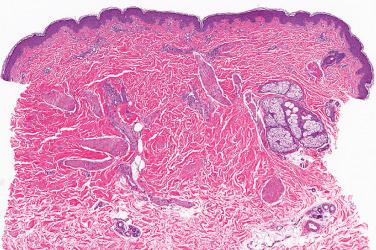
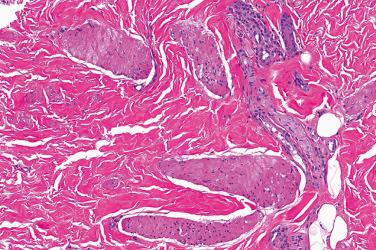
A benign smooth muscle tumor composed of interlacing fascicles of bland spindle cells displaying typical features of smooth muscle differentiation (e.g., cigar-shaped or blunt-ended nuclei and bright eosinophilic cytoplasm)
Believed to arise from or differentiate toward the arrector pili muscle
Lesions can be solitary or multiple and develop either as a sporadic or inherited condition
Most commonly develops in the second and third decades of life
Female predominance for multiple lesions, whereas solitary tumors occur more commonly in males
Congenital occurrence exceptional, likely overlapping with or representing a variant of congenital smooth muscle hamartoma
A subset of pilar leiomyoma(s) occurs in the familial setting, the so-called Reed syndrome or multiple leiomyomatosis
Autosomal-dominant mode of inheritance
Associated with germline mutation(s) of the fumarate hydratase ( FH ) gene on chromosome 1q42.3-43 acting as a tumor suppressor gene
Combination of multiple pilar and uterine leiomyomas, additionally complicated by development of a solitary multifocal or bilateral papillary renal cell carcinoma in roughly up to 20% of patients
Firm and smooth, skin-colored, red-brown to violaceous papule(s) or nodule(s)
Multiple lesions
More common than solitary lesions
Size of individual lesion usually up to 1 cm in diameter
Often tender or painful, either spontaneously or in response to cold, pressure, or emotional stimuli
Show predilection for extensor surface(s) of the extremities and trunk
Distribution can be segmental, dermatomal, linear, zosteriform, or more widespread/diffuse
Solitary lesions
Most commonly develop on the limbs
Tend to be larger than multiple tumors
Frequently asymptomatic
Rarely presentation may be with an indurated plaque
Complete surgical excision curative, but difficult to achieve in multiple tumors
Recurrence rate as high as 50% for multiple lesions
Dermal-based proliferation, extension into the subcutis infrequent
Poorly circumscribed and infiltrative, less often nodular and well circumscribed
Interweaving/interlacing fascicles of bland spindle cells displaying typical features of smooth muscle differentiation
Cigar-shaped or blunt-ended nuclei
Low mitotic activity present in roughly 30% of the lesions (fewer than 1 mitosis per 10 high-power fields)
Bright eosinophilic cytoplasm
Histological variants
Epithelioid
Symplastic
Pleomorphic cells with large, multilobated, hyperchromatic nuclei; macronucleoli; and intranuclear cytoplasmic pseudoinclusions, usually scattered among bland spindle cells
Multinucleated giant cells not uncommon
Mitotic activity low (usually fewer than 1 per 10 high-power fields)
Necrosis absent
Represents degenerative phenomenon
Positive for smooth muscle actin, desmin, calponin, and h-Caldesmon
A small percentage of cases express keratin
Cutaneous leiomyosarcoma
Metastatic leiomyosarcoma
Cellular dermatofibroma
Dermatofibrosarcoma protuberans with myoid nodules
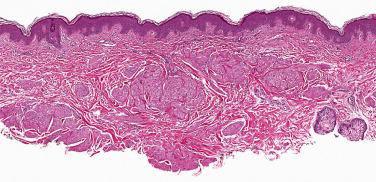
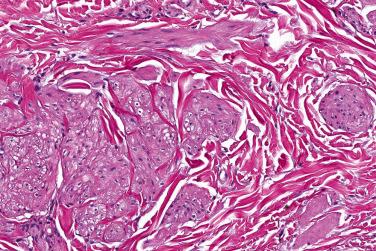
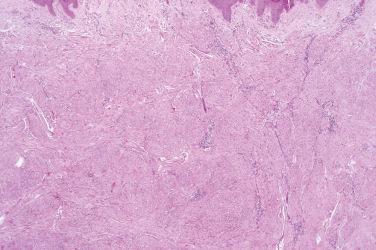
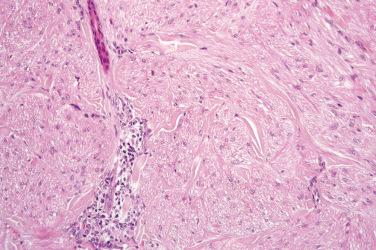
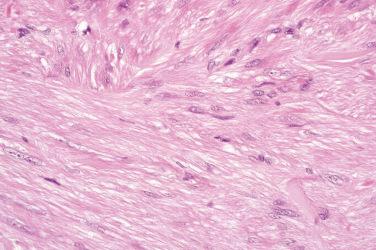
A variant of leiomyoma arising from superficial smooth muscles at genital locations, including scrotum, vulva, and nipple
Predilection for middle-aged adults
Solitary, slowly growing papule or nodule, less often a pedunculated lesion with surface ulceration
Multiple lesions most uncommon
Lesions can increase in size during pregnancy
Most of the lesions are asymptomatic
Nipple leiomyomas
Tend to be smaller (generally less than 2 cm)
Poorly circumscribed
Vulvar and scrotal leiomyomas
Size generally between 3 and 5 cm in diameter
Well circumscribed
Vulvar leiomyoma(s) can be associated with synchronous or metachronous development of esophageal leiomyoma(s), a condition known as esophagovulvar syndrome
Complete surgical excision curative
Histological features essentially similar to pilar leiomyomas, including the so-called symplastic change representing a degenerative phenomenon (see corresponding section on pilar leiomyoma)
Certain morphological features occur more commonly at genital sites (see below)
Vulvar and scrotal leiomyomas
More cellular than pilar leiomyomas
Tend to be better circumscribed and more nodular but not encapsulated
Focal or more widespread epithelioid morphology common
Myxoid change frequent, especially during pregnancy
Hyalinization of the stroma can be prominent
Variably intense perivascular inflammatory cell infiltrate composed of lymphocytes, histiocytes, and eosinophils
Smooth muscle actin, calponin, desmin, and h-Caldesmon positive
Variable positivity (over 50%) for estrogen and progesterone receptors
Androgen receptor positivity in scrotal leiomyomas
No consistent cytogenetic change in vulvar leiomyomas, yet the data is limited
Angiomyofibroblastoma
Aggressive angiomyxoma
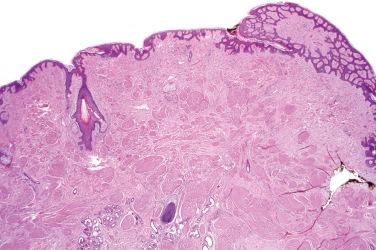
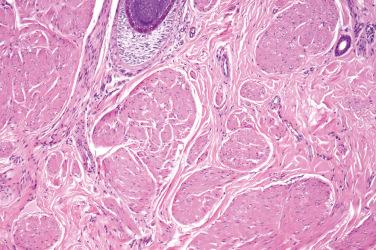
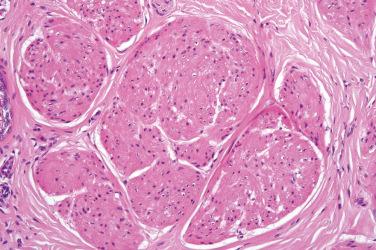
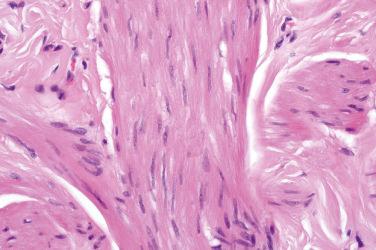
A benign tumor composed of vascular smooth muscle cells and blood vessels
Alternatively designated as a vascular leiomyoma or angiomyoma
This tumor is now regarded as part of the spectrum of pericytic (perivascular) tumors that include glomus tumor and its variants, and myopericytoma and its variants
Become a Clinical Tree membership for Full access and enjoy Unlimited articles
If you are a member. Log in here